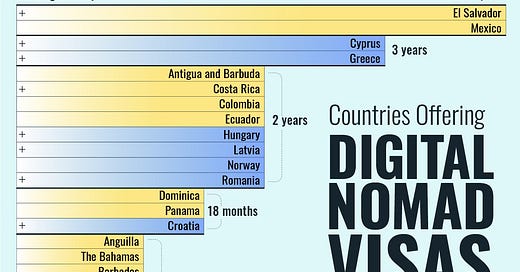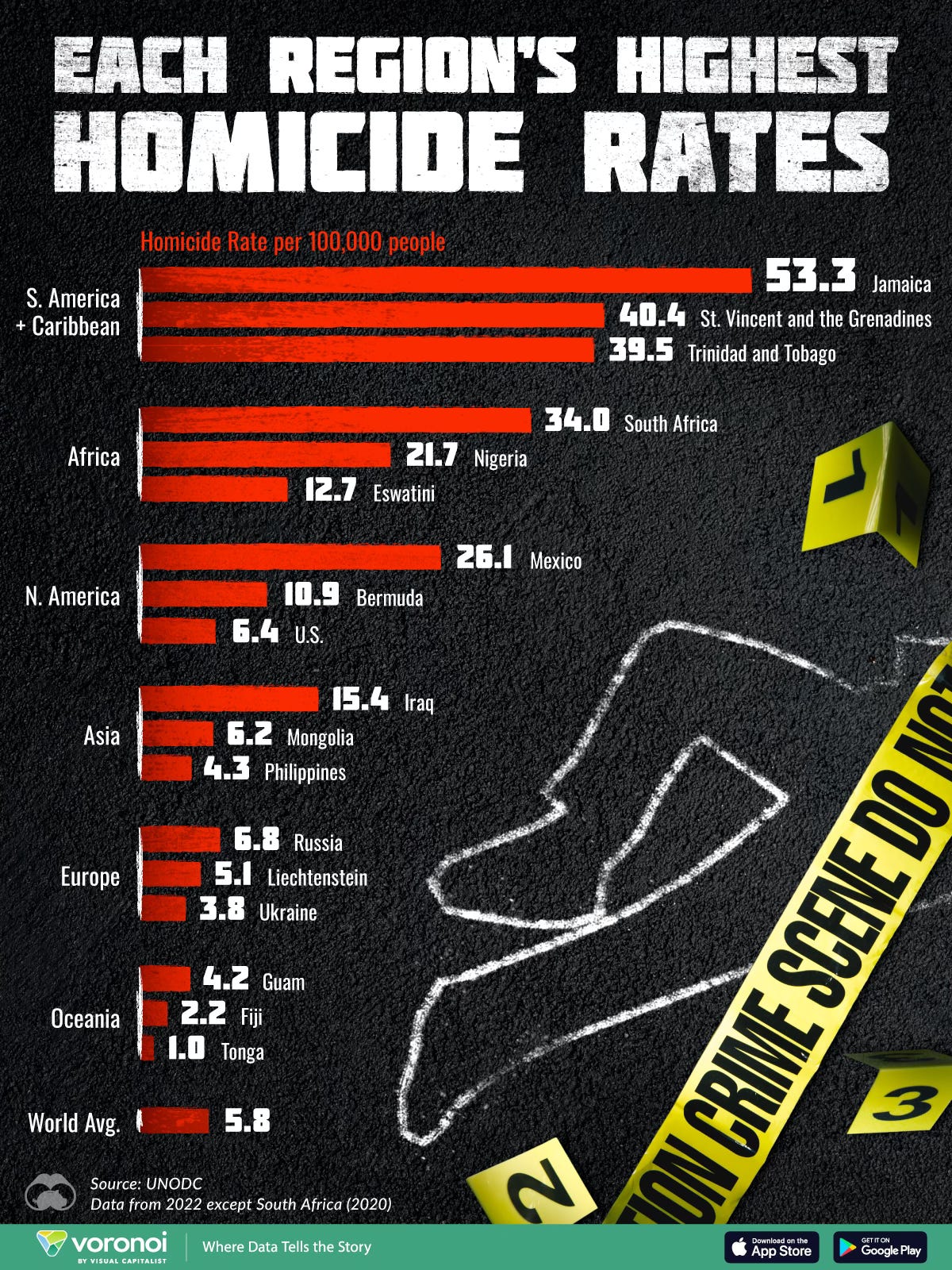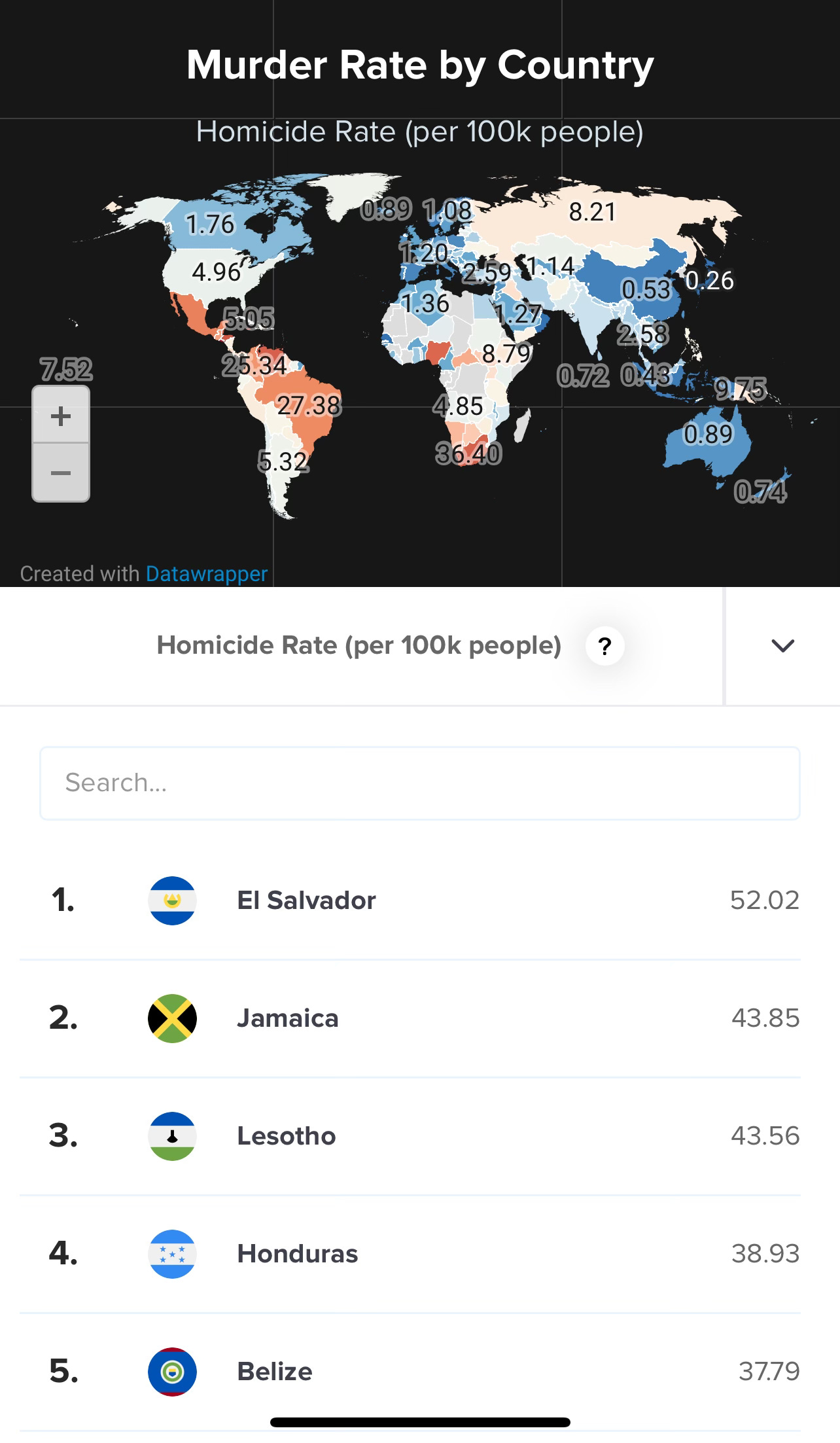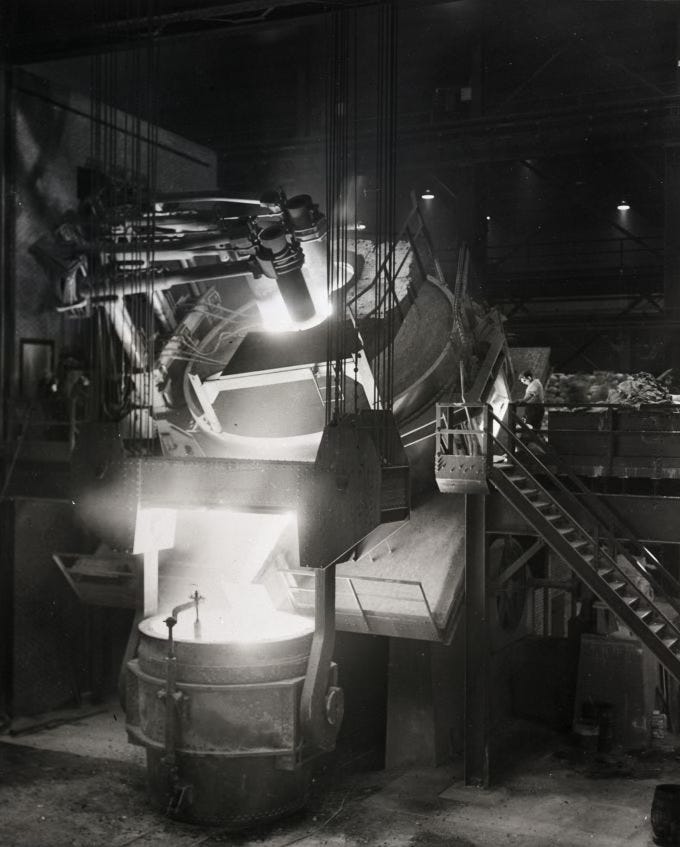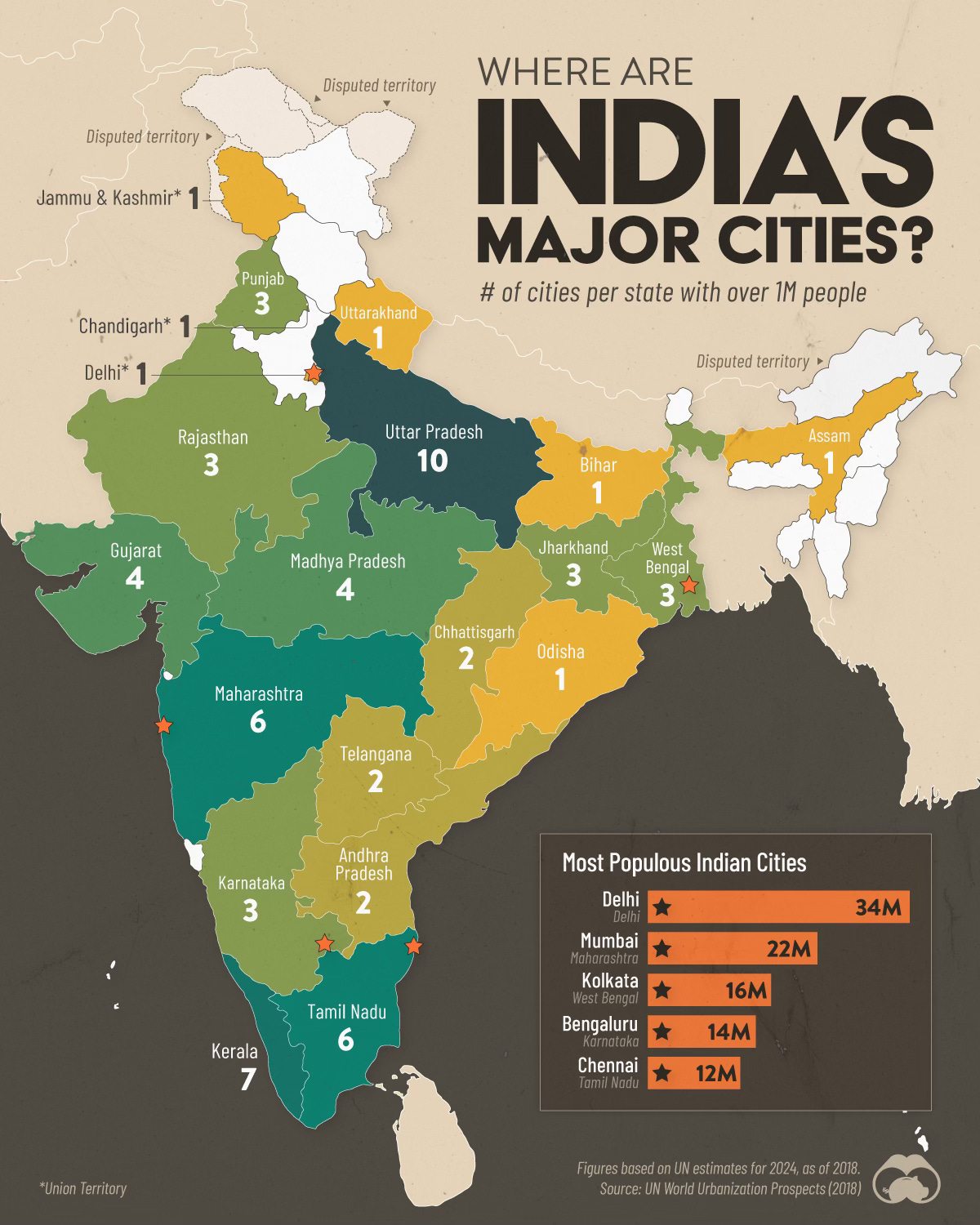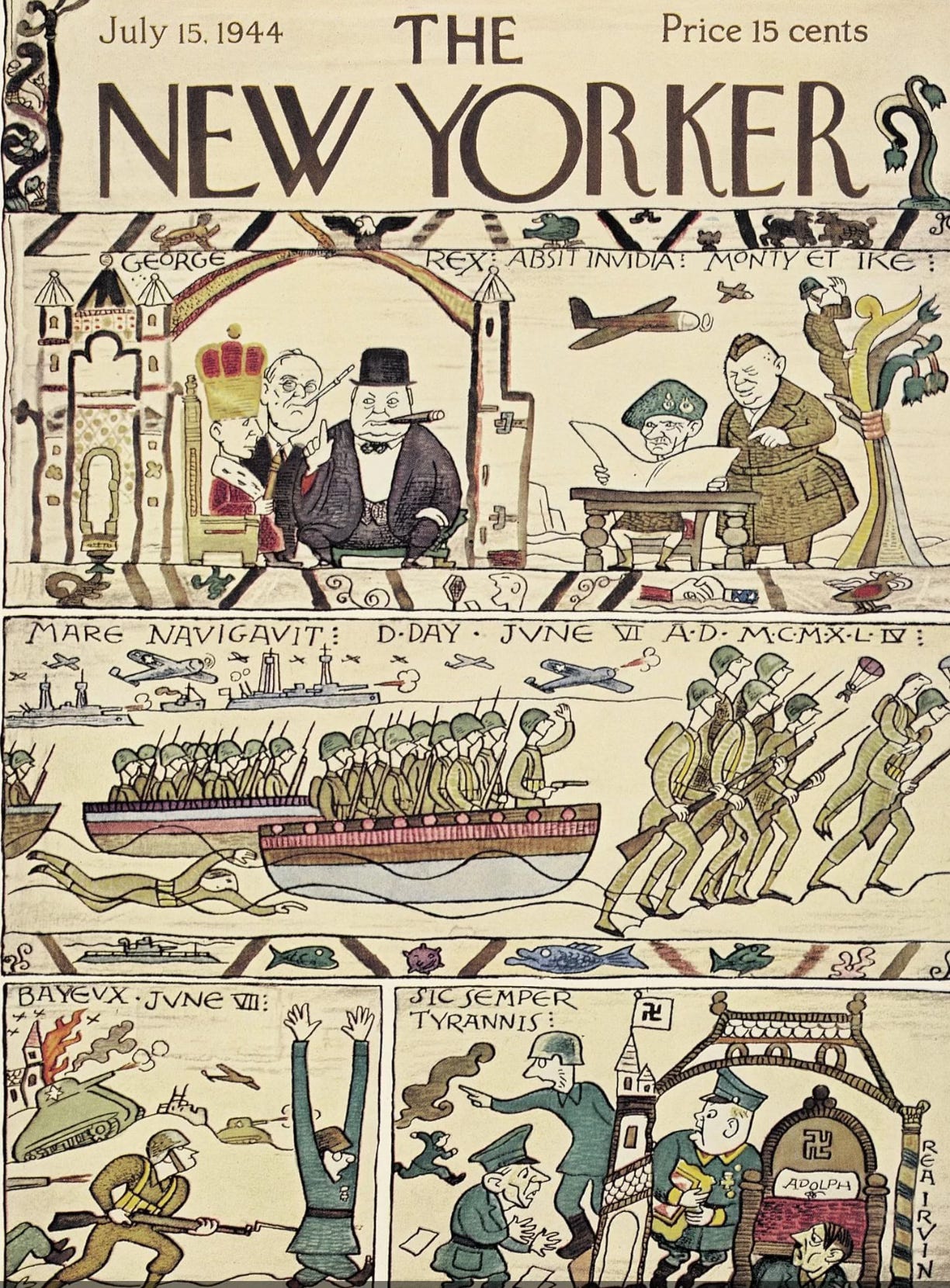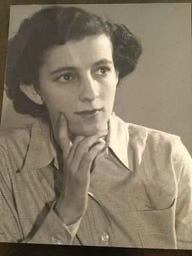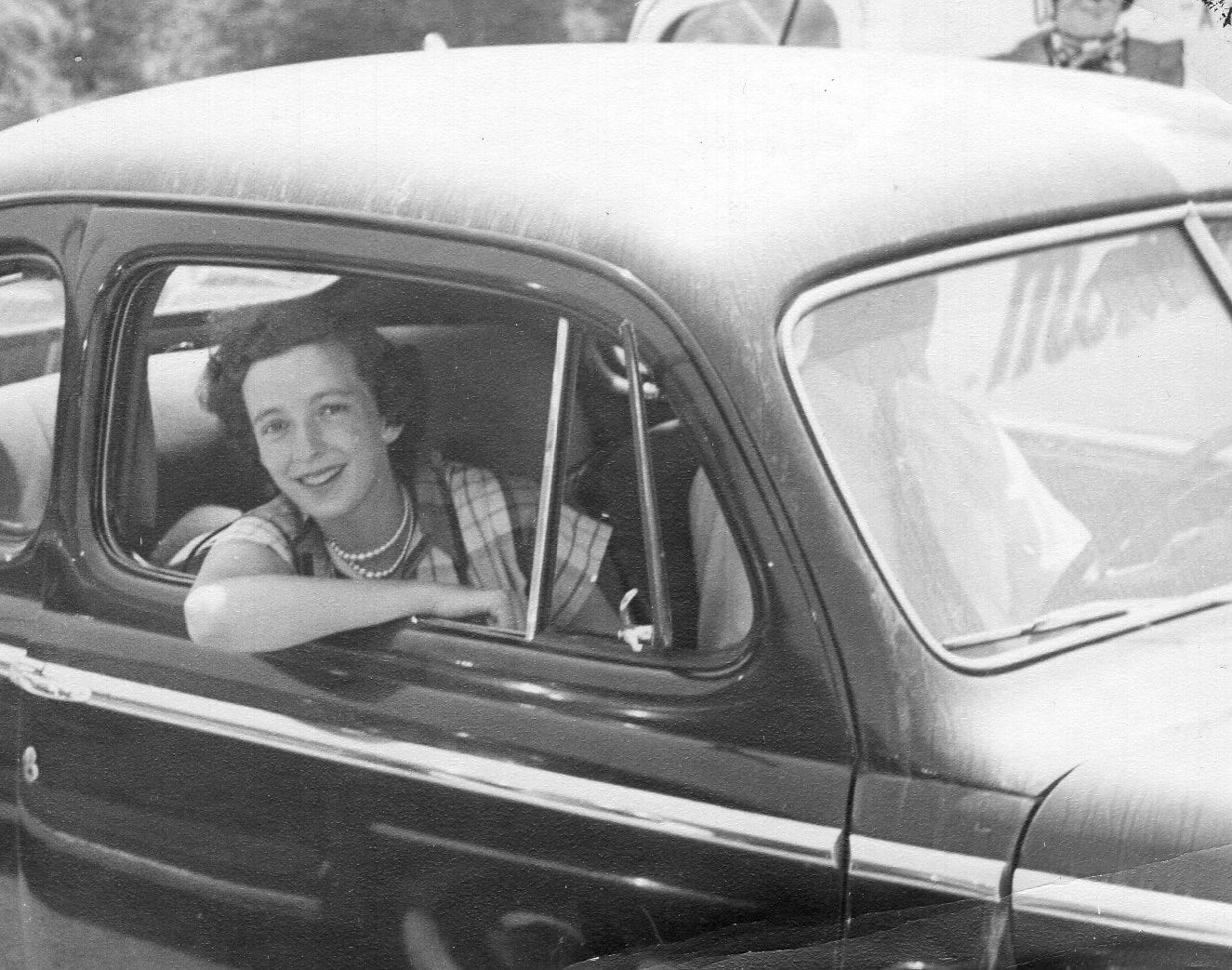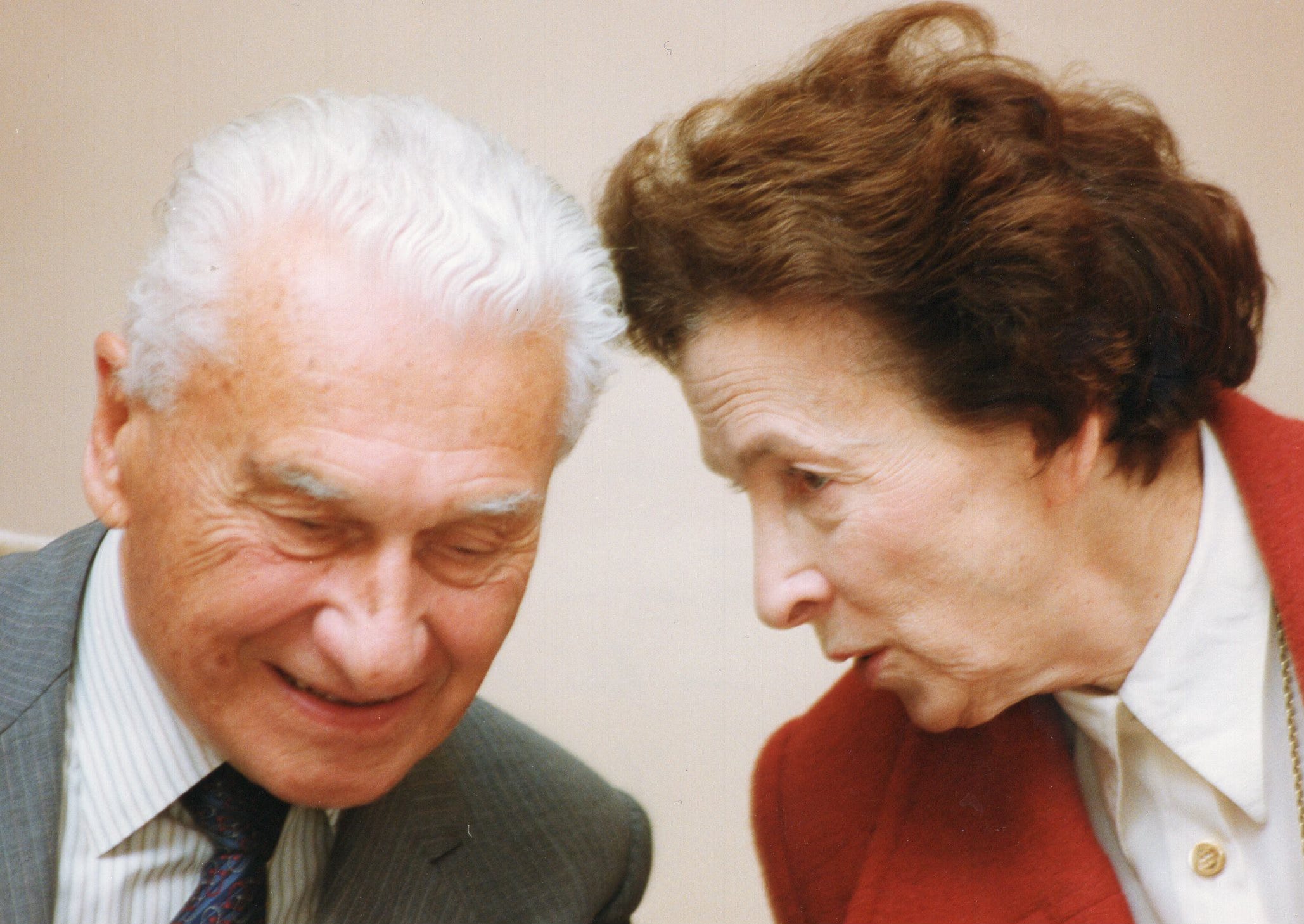Digital Nomads; Murder Capitals; US Steel and a woman who worked at the Bletchley Park Branch in Ottawa
January 10 2024, Volume 5 # 3
Second Prize is 5 years in El Salvador
A number of countries allow remote workers, also known as digital nomads, a visa for up to four years, The attraction for the worker is living in an appealing place without immigration hassles. I know the rules in Italy: you have show a contract for remote work and provide your own health care. Hard to believe that anyone would want to spend so much time in El Salvador, home to gangs, crime and civil unreast.
Dangerous Places
Other sources list El Salvador as the world’s murder capital. Central America has three of the most dangerous countries in the world.
US Steel Where are You?
American steel production peaked in 1973 at 137-million tonnes. It has dropped by as much as 40% since then. The question is: does it make any difference? The United States economy is still rich, it just doesn't make as much steel as it once did.
As for US Steel, it was once the largest steel producer in the world, formed by J.P. Morgan in 1901, by merging three big steel producers, including Carnegie Steel.
This is US Steel’s plant in Pittsburgh, the city that when this photo was taken was the third largest head office city in the United States; think Alcoa the largest aluminum company in the world, Heinz, Westinghouse, Allegheny Ludlum, Pittsburgh Plate Glass, Mellon Bank and others. It lost that title in the 1980s. This photo was obviously taken in the early 1950s. That first car is a Pontiac, two over is a Studebaker.
For a while US Steel was the largest corporation in the world. It was the first company to reach a market cap (stock price times shares outstanding) of one billion dollars. Its stock symbol was simply X and most people figured it would last forever.
From the start in 1901 it was one of the stocks on the Dow Jones Industrial Index. It was removed in 1991, a symbol of the declining rust belt in the United States. China is by far the biggest steel producer, and India is a distant number two.
Where People Live in India and China
D-Day Cover Inspired by the Bayeux Tapestry
A brilliant New Yorker cover 39 days after the D-Day landings on June 6, 1944. It was the invasion of Normandy, the same place where William the Conqueror, Duke of Normandy, set off to conquer England in 1066, an event immortalised in the Bayeux Tapestry. In the New Yorker cover, the arch over Hitler bears an eerie resemblance to the Arbeit Macht Frei portal at Auschwitz which would only be discovered five months later by Soviet troops on January 27, 1945.
Essay of the Week
During the Second World War, Sonja Morawetz (later known by her married name, Sinclair), was part of a secret code-breaking group, connected to Bletchley Park in England, which operated out of a mansion in Ottawa’s Sandy Hill district, next door to the prime minister’s residence. Known as the Examination Unit, it was so secret that she never told her husband, even though he was a military man, and he died in 2006 without learning what his wife did in the war.
She died in Toronto on May 23, six months shy of her 103rd birthday, after a long, multifaceted life that also saw her become a successful writer, raise a family and play a role in the defection of Soviet ballet star Mikhail Baryshnikov.
Sonja Morawetz was born Dec. 3, 1921, in Upice, an industrial town in northern Czechoslovakia, into a secular Jewish family. Her father, Richard, operated a jute factory and was quite rich.
The agreement at Munich in 1938, where British Prime Minister Neville Chamberlain and French president Édouard Daladier handed a huge slice of Czechoslovakia to Hitler’s Germany. It was the writing on the wall for the Morawetz family. Sonja was sent to a boarding school in England named Badminton.
At first Richard Morawetz said he was a patriot and would stay to support the Czech government. But he was eventually convinced to leave. Just before the war started, he and his wife, Frida (née Glaser) Morawetz, left everything behind and took a train from Prague through Nazi Germany to France.
In a short book Sonja wrote about her family, Mr. Morawetz recalled a terrifying moment at the border when an arrogant young German border guard asked him a trick question about whether he was really on a business trip. They made it into France and were briefly in England //where they picked up Sonja// on their way to Canada.
Almost all of the relatives they left behind either died of diseases due to maltreatment or were murdered in Nazi concentration camps, including //Sonja’s aunt,//who was too nervous to travel across the Atlantic, even though Richard found her a visa to the Dominican Republic. The Morawetz family left for Canada on Sept. 3, 1939, the day Britain and France declared war on Germany after its invasion of Poland two days earlier.
The family settled in Toronto and Sonja was accepted into the University of Toronto. She graduated from Trinity College with the gold medal and a degree in math and modern languages
.“It was that combination that mattered for her code-breaking work,” her daughter Helen Sinclair said.
The government went looking for Ms. Morawetz, offering her work at the National Research Council, which she quickly figured out was a cover for the real work they wanted her to do.
“In the spring of 1943, Morawetz was asked to come to External Affairs for an interview. She found this surprising because she hadn’t applied there. But it is in all likelihood that Trinity had suggested Morawetz as a possible employee for the Examination Unit [XU]. She was offered a job at the National Research Council. She accepted, moved to Ottawa, and started work at the XU on 7 June 1943,” Ottawa librarian Diana Pepall wrote in a pamphlet on the Examination Unit.
Once Ms. Morawetz was in Ottawa, a Mr. Stone told her she had to swear an oath of secrecy and allegiance to King George VI.
“I had no problem with the oath of secrecy, but I said I had trouble with swearing allegiance to the King, since I was still a citizen of Czechoslovakia. Stone shrugged his shoulders and said well we’ll just forget that one,” Mrs. Sinclair recalled in a recorded interview in 2017.
The British government ran the secretive Bletchley Park, where teams of clever men and women worked at breaking German codes. They were helped by knowing about Germany’s Enigma Machine, which was used to send out coded messages. A group of men and women in Ottawa were a subsection of the Bletchley Park operation, connected through the British Security Coordination in New York, run by the Canadian Sir William Stephenson, the man code-named Intrepid.
For two years the group of about 40 people in Ottawa received material in German, Japanese and French; part of France and its colonies were the Nazi puppet state known as Vichy France. The Ottawa unit of which Ms. Morawetz was part, deciphered messages sent in French to the delegation of the Vichy regime in Ottawa. Unlike Britain, Canada maintained full diplomatic relations with Vichy France until it was occupied by the Germans in November 1942. The unit continued to decode messages from the French fleet, French colonies such as those in Africa and messages from the Free French under Charles de Gaulle.
“I was told to look for certain sequences of numbers which occurred in the transmission and translate those into common words in the French language,” she recalled. “The work was quite enjoyable. It was like tackling a crossword puzzle.”
The Examination Unit was overseen by External Affairs, in particular a future prime minister of Canada.
“Throughout the Second World War, Lester B. Pearson was very closely involved with the organization of and, at times, the daily operations of the Examination Unit,” Ms. Pepall wrote in the pamphlet. CUT: The librarian was the person who in 2017 found Mrs. Sinclair when the British Government wanted to award a medal to those who served in the Canadian outpost of Bletchley Park.<we say this at the end, so we don’t need it here.
It was the stuff of wartime spy novels, and the building at 345 Laurier Avenue East in Ottawa was guarded 24 hours a day by the Veterans Guard, men who had served in the First World War. The women who worked at the Examination Unit spent a lot of time together because they couldn’t share secrets with friends or family. They spent spare time observing the habits of their next-door neighbour, prime minister William Lyon Mackenzie King.
“Anytime we weren’t busy we looked out the window and watched the prime minister walking his dog. There was no security [for the prime Minister], just an elderly man walking his dog,” Mrs. Sinclair said.
The people who worked in the Examination Unit took their oath of secrecy seriously.
“May I take this opportunity of reminding you of the Oath of Secrecy taken by all persons joining the staff of the Council,” members of the unit were told in a personal letter. “The termination of your employment does not in any way release you from this oath.”
And Sonja Morawetz kept that secret until he she was 96.
After the war she married Richard Sinclair, a high-ranking officer in the Royal Canadian Air Force who stayed in the service.
The couple moved to Edmonton, where in a most unusual incident, she was told by the RCAF chaplain there that things would be easier if she converted to Christianity, which she did.
There followed the life of the military family, moving to several Canadian cities and one overseas posting. When they were posted to Ottawa in 1956, she told her husband she was taking a degree in journalism at Carleton University. He was enthusiastic and offered to make breakfast and get the children off to school in the morning.
Even before she finished her degree, she started what became a successful freelance writing career. Before classes she would head to the CBC Radio offices in the Chateau Laurier. She was never without work at a long list of publications.
For many years she was one of the main stringers (freelance contributors) for Time Canada, then a weekly publication with a Canadian section.
“Sonja was always assigned the tricky economic stories,” said Bob Lewis, who was Toronto bureau chief of Time from 1972 to 74. “She was an elegant woman who mixed easily with Toronto’s high level business circles. It was wonderful to have an experienced grownup around.”
In addition to writing longer magazine pieces, Ms. Sinclair ghost-wrote two biographies. The first was of the Czech-born businessman, Tomas Bata, who ran his global shoe empire from Canada, his adopted country, and lived in Toronto.
The other was of George Ignatieff, the Canadian diplomat and father of Michael Ignatieff, former leader of the Liberal Party.
“I met her when she was ghost-writing my father’s memoirs in the 1980s,” Mr. Ignatieff wrote to The Globe from Budapest. “My Dad was very fond of her: sympathetic, smart and understanding.”
Mrs. Sinclair worked on several foreign assignments, including in her native Czechoslovakia. “During the Prague Spring in 1968 , my mother went to Prague to do interviews for CBC Radio,” her daughter Helen said. Though Mrs. Sinclair wrote in English, she always spoke it with a soft Czech accent.
/When the Soviet ballet star Mikhail Baryshnikov defected in 1974, Mrs. Sinclair was among a small group of Canadians who helped make it happen. After a performance in Toronto, he was whisked away to a farm outside the city then to a cottage on island owned by Sonja and Richard Sinclair.
It was a safe place for the dancer to stay until he was assured that Canada was not going to deport him back to the USSR. Mr. Baryshnikov later told a friend, “the people are nice, but it is very boring.”
After the fall of Communism in Eastern Europe, Mrs. Sinclair went to her native Czechoslovakia, where she interviewed Vaclav Havel, the writer who had become the country’s president.
Back in Canada she did some work for Price Waterhouse. “It was internal communications, telling those accountants to use words that ordinary people could understand,” Helen Sinclair said.
In 2009, the British government officially relaxed the rules of the Official Secrets Act for people who worked at Bletchley Park. CUT: Not many people in Canada knew about it.The British government wanted to award badges to the likes of Mrs. Sinclair, and it was Ms. Pepall, the Ottawa librarian, who located her and others.
Mrs. Sinclair was given the Bletchley Park Commemorative Badge at a ceremony in Toronto in June, 2017. Former governor-general Adrienne Clarkson and former Liberal Party leader Bob Rae spoke at the event.
Mrs. Sinclair told a number of stories, including one illustrating how she chose to be loyal to her adopted country rather than her native country during the war.
“Outside the Examination Unit, I met a number of people including the military attaché of the Czechoslovak embassy in Ottawa. He said to me one day if you had any information that might be of interest to the Czechoslovak government-in-exile, surely you would share it with me. I laughed and I said I have no such information and I changed the subject.”
Mrs. Sinclair leaves her children, Michael, Helen and Tony; four grandchildren and five great-grandchildren.

